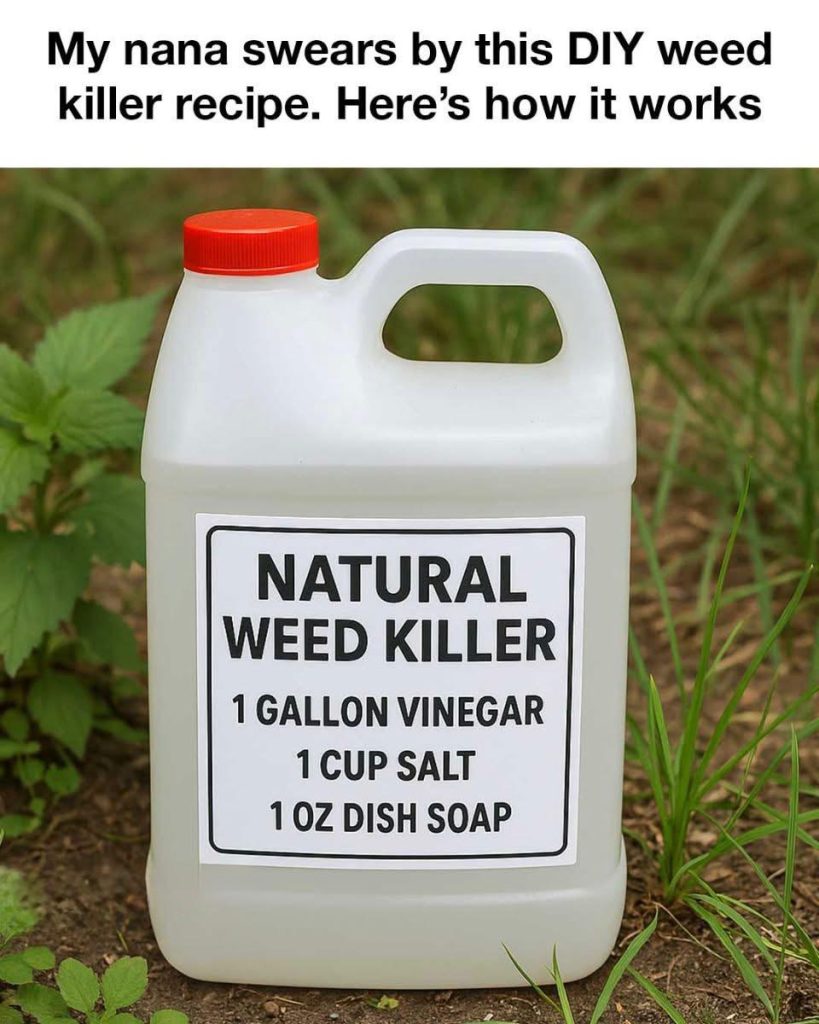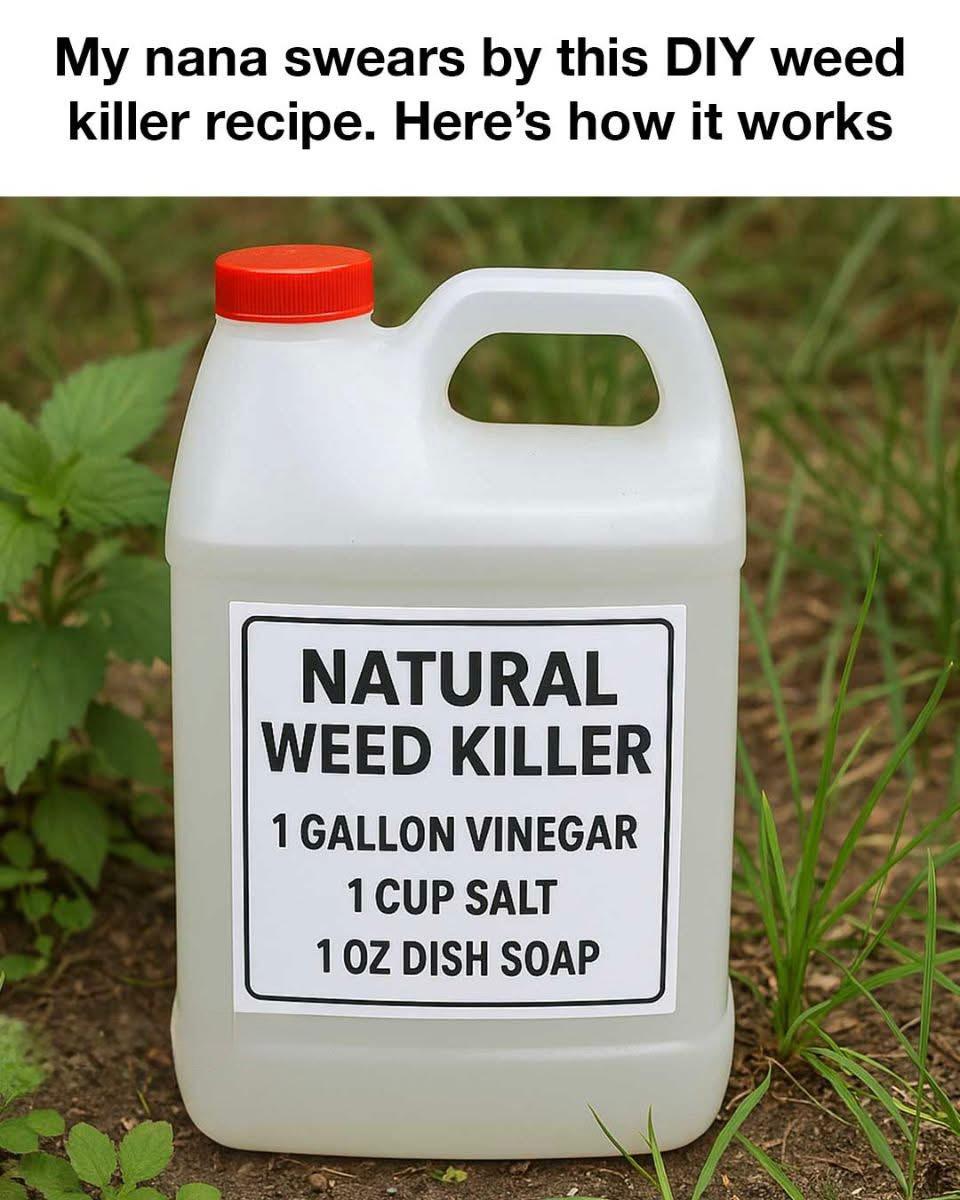
🌿 DIY Natural Weed Killer Recipe
📝 Introduction
Tired of chemical-laden herbicides that harm your soil, pets, or even your health? This DIY Natural Weed Killer is a time-tested solution that’s as effective as it is eco-friendly. Trusted by gardeners for generations — including “Nana,” as the image sweetly says — this homemade formula uses common household ingredients to eliminate weeds naturally without poisoning your garden.
🧾 Ingredients
To prepare 1 gallon of natural weed killer:
- ✅ 1 gallon (3.8 liters) white vinegar (5% acetic acid or stronger)
- ✅ 1 cup salt (table salt, rock salt, or Epsom salt)
- ✅ 1 oz (2 tablespoons) dish soap (biodegradable preferred)
🛠️ Instructions
- Mix Ingredients:
- In a large container or directly in a sprayer, pour 1 gallon of white vinegar.
- Add 1 cup of salt and stir until dissolved.
- Add 1 oz of dish soap and mix gently to avoid suds.
- Transfer:
- Carefully pour the solution into a spray bottle or garden sprayer.
- Application:
- Spray directly onto unwanted weeds on a sunny day.
- Avoid rainy or windy days for best results.
- Saturate the weed leaves and base, but avoid spraying nearby plants you want to keep.
- Wait and Watch:
- Weeds will begin to wilt in 2–6 hours and dry out within 24 hours.
🧪 Methodology / How It Works
Each ingredient plays a vital role:
- Vinegar: The acetic acid draws moisture out of the plant, causing it to dry out and die.
- Salt: Dehydrates the plant further and prevents regrowth by altering the soil.
- Dish Soap: Breaks the surface tension of the vinegar, helping it stick to the leaves more effectively.
This combo works best on sunny days, as sunlight accelerates the drying effect.
📜 History
Before chemical herbicides existed, people turned to household acids and salts to control weeds. In many rural areas and among traditional gardeners like “Nana,” recipes like this have been used for generations, passed down through families as a safer alternative.
Historically:
- Vinegar has been used since ancient Roman times for cleaning and plant control.
- Salt was used in warfare to ruin agricultural land (“salting the earth”).
- Soap has been part of gardening since the 1800s for pest and plant treatment.
💚 Benefits
- 🌱 Eco-friendly and biodegradable
- 🐶 Pet-safe when dry
- 👶 Child-safe compared to chemical herbicides
- 💵 Budget-friendly (costs pennies per batch)
- 🌿 No harsh chemicals or synthetic poisons
- 💪 Effective on most common weeds (dandelions, crabgrass, thistle, etc.)
🧬 Formation / Chemistry
- Acetic acid (CH₃COOH) in vinegar lowers pH and burns plant cells.
- Sodium chloride (NaCl) in salt disrupts water absorption.
- Surfactants in dish soap reduce surface tension, improving penetration.
This results in cellular dehydration of weeds, making it difficult for them to survive or regenerate.
🥗 Nutrition (Not applicable directly, but here’s context)
Although not edible, the natural ingredients mean there’s no toxic residue left in the garden. This is particularly important for vegetable gardens, fruit trees, and herbs. It keeps the soil chemical-free and healthy for future planting — indirectly supporting nutritious food growth.
💞 Conclusion with Lovers
For garden lovers, nature enthusiasts, and those who prefer organic gardening, this DIY weed killer is a dream come true. It embodies the love of nature, the wisdom of tradition, and the spirit of sustainable living. Whether you’re planting roses or tomatoes, keeping weeds at bay is an act of love — for your plants, your soil, and your planet.
🌼 Final Notes for Gardening Lovers
- 🔁 Repeat weekly for stubborn weeds.
- ⚠️ Don’t spray near plants you want to keep — it’s non-selective.
- 🧴 Store leftovers in a cool, dark place and label clearly.
💬 “My nana always said: ‘Take care of your garden, and it will take care of you.’”
